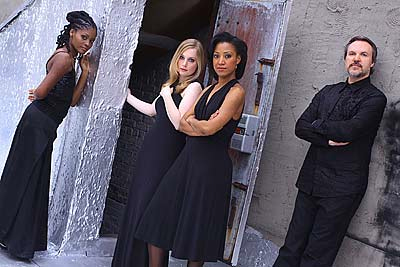by Nicholas Jones

O’Connor, who performed last week with his string quartet on the Cleveland Museum of Art’s “Masters of the Violin” series, has a formidable violin technique, based on what he calls the “language” of bluegrass, with dazzling arpeggios, energetic and persistent double stops, prominent slides, percussive “bow crunches,” and—above all— rhythmic drive. O’Connor has very successfully elevated his traditional Appalachian fiddle techniques to embrace the classical concert stage. He is a prolific composer in this mode, and has created a popular series of pedagogical materials, including workshops and summer camps, to build interest in the progressive bluegrass style that has come to be known as “newgrass.”
Introduced from the stage, the program included a few shorter pieces, especially duets at the beginning with each of the members of his string quartet, as well as a dazzling solo improvisation by O’Connor himself.
But most of the evening was comprised of two full string quartets, both composed by O’Connor. Both were superbly performed, with fine intonation and ensemble. The young performers who join O’Connor in this quartet are excellent players in their own right, and clearly enjoy playing together. O’Connor, citing the example of another composer-performer, Mozart, puts himself as second violin in the quartet, but no one played “second fiddle” in this concert, particularly since O’Connor’s writing gives strong parts to each voice.
The quartet called “Bluegrass,” his second in the genre, dates from 2005 and brings bluegrass into synthesis with a number of other modes such as fugue, gospel, and dissonant modernism. I particularly enjoyed the second movement, a scherzo with a haunting “perpetual motion” section sporting a sassy, almost adolescent attitude.
O’Connor’s third string quartet, from 2008, subtitled “Old-Time,” is a more coherent composition than the earlier quartet. The piece, in four movements, has a rich, full sound and a sense of direction. As O’Connor says, it builds steadily toward its final movement, a “hoedown” remarkable for its wealth of musical languages.
In his program notes and concert presentations, on his website, and through his extensive work in string pedagogy, O’Connor offers the hoedown as a historical model and a metaphor for the mixing of diverse American musical languages and cultures. For him, it is a communal gathering with bluegrass roots, but with resonance for many other modes, such as jazz, gospel, blues, Native American music, and even rock.
O’Connor clearly believes that fiddling in the “newgrass” mode can unite a number of diverse cultures through music. The diversity of his own music (and, incidentally, of the personnel of his quartet) certainly go a long way to putting that argument into reality. But, while I came away from the concert with a great respect for his talent and his mission, I was not convinced that his string quartets themselves are strong enough to carry his ideas across in concert. His best music, I think, is in shorter pieces that more directly reflect the rural traditions themselves, such as the poignant “Appalachian Waltz” widely known through performances with O’Connor by Edgar Meyer and Yo-Yo Ma (it was played as an encore at this concert).
His string quartets, by contrast, lack the sustaining power and inventiveness that has become such a hallmark of the genre. O’Connor’s contributions to the string quartet literature seem over-packed with technique and energy, and slim on development and form.
For a composer to end a quartet with a hoedown or to write a piece with “Appalachian” in the title — invites comparison with Aaron Copland. Ironically, that resolutely classical, Europeanized, and urban composer comes closer than O’Connor to adapting the rural American languages of music. One reason may have to do with Copland’s ear for finding unforgettable and masterful tunes (“‘Tis the gift to be simple,” the basis of “Appalachian Spring,” is his most famous borrowing). O’Connor makes a point of not doing so: he asserts that he wants to invent his themes himself, not borrow them, a stance that is commendable and perhaps more ethical. But it doesn’t seem to produce as striking results in the concert hall.
That said, the evening was a striking performance by four excellent musicians, playing new music composed by one of the performers himself—a rare occurrence in the modern art-music world. A number of young people attended the concert, violinists themselves, I imagine. I hope that they came away inspired to create, and perform, new music of their own.
Nicholas Jones is Professor of English at Oberlin College.
Published on ClevelandClassical.com November 5, 2013
Click here for a printable version of this article.



